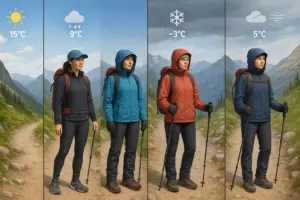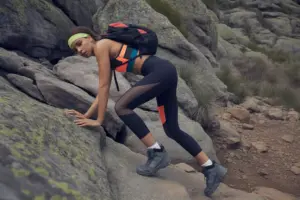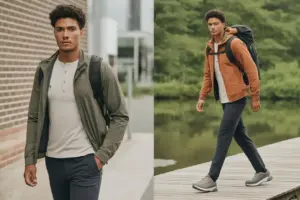Cool Weather Clothes for Camping: The Complete 2025 Guide to Staying Warm and Comfortable Outdoors
Picture this: you’re sitting around a crackling campfire under a star-filled sky, perfectly warm and comfortable despite the crisp mountain air that has other campers shivering in their inadequate gear. The difference between a magical cool-weather camping experience and a miserable one often comes down to one crucial factor—having the right clothing.

Cool weather camping opens up incredible opportunities to explore nature without crowds, witness stunning fall foliage, and enjoy crystal-clear night skies. However, dropping temperatures, unpredictable weather, and increased moisture levels create unique challenges that require strategic clothing choices. Whether you’re planning a late-season backpacking trip or extending your camping season into the shoulder months, understanding how to dress properly can make or break your outdoor adventure.
Key Takeaways
- Layer strategically with moisture-wicking base layers, insulating mid-layers, and waterproof outer shells to maintain warmth and comfort
- Choose the right materials like merino wool and synthetic fabrics while avoiding cotton, which loses insulation when wet
- Don’t forget extremities – proper hats, gloves, and insulated footwear are essential for preventing heat loss and maintaining circulation
- Pack backup clothing including extra socks, dry layers, and emergency warm gear stored in waterproof bags
- Adapt your clothing system based on activity level, weather conditions, and time of day to optimize comfort and safety
Understanding Cool Weather Camping Challenges
Cool weather camping presents unique obstacles that warm-weather gear simply can’t handle. Temperature regulation becomes critical as your body works harder to maintain core warmth, especially during periods of low activity like sleeping or sitting around camp.
Moisture management poses another significant challenge. Cool air holds less moisture, leading to increased condensation inside tents and on gear. Combined with potential rain, snow, or morning dew, staying dry becomes paramount to staying warm.
The shorter daylight hours typical of cool weather seasons mean more time spent in camp during the coldest parts of the day. This extended exposure to low temperatures requires clothing that performs well during both active hiking periods and sedentary camp time.
Temperature Ranges and Clothing Needs
- Mild Cool (45-60°F): Light layering with focus on adaptability
- Moderate Cool (30-45°F): Full three-layer system with insulation
- Cold (15-30°F): Heavy insulation and winter-specific gear
- Extreme Cold (Below 15°F): Specialized cold-weather equipment
The Science of Layering for Cool Weather
The layering system forms the foundation of effective cool weather camping clothing. This time-tested approach allows for precise temperature regulation while maintaining protection from the elements.
Base Layer: Your Foundation
The base layer sits directly against your skin and serves as your moisture management system. Its primary job is wicking sweat away from your body while providing a thin layer of insulation.
Material Options:
- Merino Wool: Natural odor resistance, excellent temperature regulation, retains warmth when wet
- Synthetic Fabrics: Quick-drying, durable, often more affordable than wool
- Silk: Lightweight, compact, good for mild conditions
What to Avoid: Cotton base layers trap moisture and lose all insulating properties when wet, creating a dangerous situation in cool weather.
Mid Layer: Your Insulation Engine
The mid layer provides the bulk of your thermal insulation by trapping warm air close to your body. The thickness and type of mid layer should vary based on expected temperatures and activity levels.
Popular Mid Layer Options:
- Fleece Jackets: Breathable, quick-drying, maintains warmth when damp
- Down Insulation: Excellent warmth-to-weight ratio, compressible, best in dry conditions
- Synthetic Insulation: Performs well when wet, dries quickly, more affordable than down
- Wool Sweaters: Natural temperature regulation, wind resistance, classic comfort
Outer Layer: Your Weather Shield
The outer layer, or shell, protects you from wind, rain, and snow while allowing moisture vapor to escape from inner layers.
Shell Types:
- Waterproof-Breathable: Full weather protection with vapor transmission
- Soft Shells: More breathable, wind and water resistant, better for active use
- Hard Shells: Maximum weather protection, less breathable, ideal for harsh conditions
Essential Cool Weather Camping Clothing Items
Upper Body Essentials
Long-Sleeve Base Layers
Invest in quality long-sleeve base layer tops in both lightweight and midweight options. Having multiple base layers allows you to adapt to changing conditions and ensures you have dry backup options.
Insulating Mid Layers
Pack at least one substantial mid layer like a fleece jacket or insulated vest. Consider bringing both a lighter option for active periods and a heavier option for camp time.
Weather Protection
A quality rain jacket serves double duty as wind protection and precipitation barrier. Look for features like pit zips for ventilation and a hood that fits over a warm hat.
Lower Body Protection
Base Layer Bottoms
Thermal underwear or long johns provide crucial leg insulation, especially during sleep and inactive periods. Choose moisture-wicking materials that won’t bind during movement.
Insulating Pants
For moderate to cold conditions, pack insulated pants or heavy fleece pants for camp wear. These can be worn over base layers or hiking pants for additional warmth.
Outer Layer Pants
Waterproof rain pants protect against wet conditions and add significant wind protection. Many models feature side zips for easy on/off over boots.
Extremity Protection
Head and Neck
- Warm Hat: Wool or fleece beanie that covers ears
- Sun Hat: For daytime protection and warmth
- Neck Gaiter: Versatile protection that can cover neck, face, or head
- Balaclava: Full head coverage for extreme conditions
Hands and Arms
- Liner Gloves: Thin gloves for dexterity during camp tasks
- Insulated Gloves: Warm gloves for general use
- Mittens: Maximum warmth for extreme conditions
- Waterproof Gloves: Essential for wet conditions
Feet and Legs
- Wool Socks: Multiple pairs in different weights
- Liner Socks: Prevent blisters and add warmth
- Gaiters: Keep snow and debris out of boots
- Camp Booties: Insulated footwear for around camp
When planning your camping gear setup, remember that proper clothing works as a system with your shelter and sleeping bag selection to maintain warmth throughout the night.
Material Guide: What Works and What Doesn’t

Superior Cool Weather Materials
Merino Wool 🐑
- Pros: Natural odor resistance, temperature regulation, retains warmth when wet, comfortable against skin
- Cons: More expensive, requires careful washing, can be less durable
- Best For: Base layers, socks, mid layers
Synthetic Insulation 🧪
- Pros: Maintains warmth when wet, quick-drying, machine washable, affordable
- Cons: Less compressible than down, can retain odors
- Best For: Jackets, pants, gloves in wet conditions
Down Insulation 🪶
- Pros: Excellent warmth-to-weight ratio, highly compressible, long-lasting
- Cons: Loses insulation when wet, slow to dry, requires special care
- Best For: Dry conditions, sleeping bags, lightweight jackets
Materials to Avoid
Cotton ❌
Cotton absorbs moisture and loses all insulating properties when wet. It dries slowly and can lead to hypothermia in cool, wet conditions. Avoid cotton t-shirts, jeans, and cotton socks for cool weather camping.
Heavy Denim ❌
While not as problematic as cotton in base layers, heavy denim jeans restrict movement, dry slowly, and provide poor insulation for outdoor activities.
Activity-Specific Clothing Strategies
Hiking and Active Periods
During high-output activities, your body generates significant heat. The key is wearing fewer layers that can be easily adjusted as your activity level changes.
Active Period Strategy:
- Lightweight base layer
- Minimal or no mid layer
- Shell layer readily accessible
- Ventilation features utilized (pit zips, leg zips)
Camp Time and Low Activity
When you stop moving, your body’s heat production drops dramatically. This transition period is when many campers get cold, so be proactive about adding layers.
Camp Time Strategy:
- Add insulating mid layer immediately upon stopping
- Put on warm hat and gloves
- Change to dry base layer if needed
- Add insulated pants or camp pants
Sleep System Clothing
Your sleep clothing works in conjunction with your sleeping bag and pad to maintain warmth through the night. The goal is staying warm without overheating and sweating.
Sleep Clothing Guidelines:
- Clean, dry base layers
- Dry socks (change if day socks are damp)
- Warm hat for cold conditions
- Avoid overdressing, which leads to sweating
For comprehensive guidance on optimizing your sleep system, consider how your clothing choices integrate with your sleeping bag’s temperature rating.
Weather-Specific Clothing Adjustments
Rainy Conditions 🌧️
Wet weather requires prioritizing waterproof protection while maintaining breathability to prevent internal moisture buildup.
Rainy Weather Essentials:
- Waterproof jacket with sealed seams
- Rain pants for extended exposure
- Waterproof gloves or pogies
- Gaiters to protect legs and boots
- Extra dry clothing stored in waterproof bags
Windy Conditions 💨
Wind dramatically increases heat loss through convection. Wind protection becomes as important as insulation in these conditions.
Wind Protection Strategy:
- Wind-resistant outer layers
- Secure hat with chin strap
- Face protection (balaclava or face mask)
- Windproof gloves
- Shelter clothing layers from wind exposure
Snow and Extreme Cold ❄️
Snow camping requires specialized gear and clothing strategies to handle both the cold temperatures and wet conditions from melting snow.
Snow Camping Additions:
- Insulated, waterproof boots
- Snow gaiters or boot covers
- Face protection for wind and sun
- Extra insulation layers
- Emergency warming items
Packing and Organization Tips
Strategic Packing Methods
Waterproof Organization 📦
Use dry bags or waterproof stuff sacks to organize clothing by type and keep backup dry clothes completely protected from moisture.
Accessibility Planning 🎒
Pack frequently needed items like rain gear and extra layers in easily accessible locations. Your backpack organization should prioritize quick access to weather protection.
Essential Backup Items
Emergency Dry Clothes
Always pack one complete set of dry clothing sealed in a waterproof bag. This emergency set should include:
- Dry base layer top and bottom
- Dry socks and underwear
- Dry insulating layer
- Emergency heat sources
Repair and Maintenance Kit
Include basic repair items for clothing failures:
- Duct tape for quick patches
- Safety pins for temporary fixes
- Seam sealer for waterproof gear
- Spare gloves and socks
Safety Considerations and Emergency Preparedness

Recognizing Hypothermia Warning Signs
Early Warning Signs:
- Uncontrollable shivering
- Loss of coordination
- Confusion or poor decision-making
- Slurred speech
- Fatigue
Prevention Through Clothing:
- Stay dry and change wet clothes immediately
- Add layers before feeling cold
- Keep extremities warm and dry
- Maintain proper nutrition and hydration
Emergency Warming Strategies
If someone shows signs of hypothermia, immediate action is required:
- Remove from cold environment (get into tent or shelter)
- Remove wet clothing and replace with dry layers
- Add insulation including hat and warm layers
- Provide warm, sweet drinks if person is conscious
- Seek immediate medical attention for severe cases
Consider including emergency items in your first aid kit specifically for cold weather emergencies, such as chemical hand warmers and emergency bivvy sacks.
Budget-Friendly Cool Weather Clothing Options
Building a System on a Budget
Prioritize Key Items 💰
Focus your budget on items that provide the most safety and comfort:
- Quality base layers
- Waterproof outer shell
- Warm hat and gloves
- Good socks
Smart Shopping Strategies
- Shop end-of-season sales
- Consider previous year models
- Look for multi-use items
- Check thrift stores for wool and fleece items
DIY and Alternative Solutions
Layering with Regular Clothes
You can create an effective layering system using modified regular clothing:
- Wool sweaters as mid layers
- Synthetic athletic wear as base layers
- Rain gear from hardware stores
- Wool socks from any outdoor retailer
Maintenance and Care for Cool Weather Gear
Proper Cleaning Techniques
Wool Care 🧼
- Use wool-specific detergents
- Wash in cool water
- Air dry flat to prevent stretching
- Store clean and completely dry
Synthetic Gear Care
- Machine wash in cool water
- Avoid fabric softeners (reduces wicking)
- Tumble dry low or air dry
- Check manufacturer specifications
Waterproof Gear Maintenance
- Clean regularly to maintain breathability
- Reapply DWR (Durable Water Repellent) coating annually
- Repair small holes immediately
- Store uncompressed when possible
Extending Gear Lifespan
Proper Storage 📦
- Store all gear clean and completely dry
- Avoid compression storage for insulated items
- Use cedar blocks to deter insects
- Check stored gear periodically
Field Care
- Air out damp gear when possible
- Avoid sitting or kneeling on gear
- Keep gear away from campfire sparks
- Pack carefully to avoid snags and tears
🏕️ Cool Weather Camping Clothing Calculator
Special Considerations for Family Camping
When camping with kids, cool weather clothing requirements become even more critical. Children lose heat faster than adults and may not recognize when they’re getting too cold.
Kids’ Cool Weather Clothing
Size Considerations 👶
- Buy slightly larger sizes to accommodate layering
- Ensure gloves and hats fit securely but aren’t too tight
- Pack extra clothing as kids get dirty and wet more frequently
Safety Features
- Bright colors for visibility
- Reflective elements for low light
- Easy-to-use zippers and fasteners
- No drawstrings that could pose choking hazards
Comfort Priorities
- Soft materials against skin
- Non-restrictive fits for play
- Easy bathroom access (avoid complicated layering systems)
Family Activity Planning
Plan family camping activities that keep everyone warm and engaged during cool weather. Active games and structured activities help maintain body heat and prevent boredom during longer periods in camp.
Advanced Cool Weather Clothing Techniques

Vapor Barrier Systems
For extreme cold conditions, vapor barrier systems can significantly improve warmth by trapping body heat and moisture next to the skin. This advanced technique requires specific gear and knowledge but can be invaluable in very cold conditions.
How Vapor Barriers Work:
- Thin, non-breathable layer (plastic or coated fabric) worn next to skin
- Traps body heat and creates warm microclimate
- Prevents moisture loss that leads to cooling
- Most effective in temperatures below 20°F
Clothing Ventilation Strategies
Active Ventilation 🌬️
Learn to use ventilation features proactively:
- Open pit zips before you start sweating
- Remove hat and gloves during uphill sections
- Unzip base layers when working around camp
- Use leg zips on pants for temperature control
Strategic Layer Removal
Develop a system for quickly adding and removing layers:
- Practice layer changes with gloves on
- Keep frequently adjusted items easily accessible
- Use clothing with easy-to-operate zippers and fasteners
Seasonal Transition Strategies
Extending Your Camping Season
Spring Camping 🌸
Early season camping often involves wide temperature swings and unpredictable weather:
- Pack for both warm days and cold nights
- Expect muddy, wet conditions
- Include sun protection for longer days
Fall Camping 🍂
Late season camping offers beautiful conditions but requires preparation for winter weather:
- Monitor weather forecasts closely
- Pack winter gear for unexpected storms
- Include extra food and fuel for cold weather cooking
For those interested in developing more comprehensive outdoor skills, consider building a bushcraft survival kit that complements your cool weather clothing system.
Technology and Cool Weather Clothing
Modern Fabric Technologies
Phase Change Materials 🔬
Some modern base layers incorporate phase change materials that absorb and release heat to maintain consistent temperature.
Advanced Synthetic Insulations
New synthetic insulations like PrimaLoft and Climashield offer down-like performance with better wet weather characteristics.
Smart Textiles
Emerging technologies include:
- Self-heating fabrics
- Moisture-responsive materials
- Integrated heating elements
Wearable Technology Integration
Heated Clothing 🔥
Battery-powered heated gloves, socks, and jackets can provide supplemental warmth for extreme conditions or cold-sensitive individuals.
Temperature Monitoring
Wearable devices can help monitor core body temperature and alert you to dangerous cooling trends.
Environmental Impact and Sustainable Choices
Eco-Friendly Material Options
Recycled Synthetic Fabrics ♻️
Many manufacturers now offer insulation and shell materials made from recycled plastic bottles and textile waste.
Responsibly Sourced Down
Look for Responsible Down Standard (RDS) certified down products that ensure ethical treatment of animals.
Natural Fiber Alternatives
Consider clothing made from sustainable natural fibers like:
- Organic wool
- Hemp blends
- Tencel/Lyocell
- Recycled wool
Extending Gear Lifespan
Repair Instead of Replace 🔧
Learn basic repair skills to extend the life of your cool weather clothing:
- Patch small holes in shells
- Re-waterproof treated fabrics
- Replace worn zippers
- Darn wool socks
Proper Care and Storage
Following manufacturer care instructions and proper storage techniques can double or triple the lifespan of quality outdoor clothing.
Regional Considerations
Mountain Environments
High Altitude Factors ⛰️
- Increased UV exposure requires sun protection even in cool weather
- Rapid weather changes demand versatile layering systems
- Wind exposure increases dramatically with elevation
Coastal Cool Weather
Marine Environment Challenges 🌊
- High humidity affects insulation performance
- Salt air can damage gear over time
- Fog and mist create persistent moisture
Desert Cool Weather
Desert Night Cooling 🏜️
- Extreme temperature swings from day to night
- Low humidity affects comfort and gear performance
- Clear skies increase radiative heat loss
Emergency Preparedness and Cool Weather
Cold Weather Emergency Kit
Beyond your regular first aid supplies, cool weather camping requires additional emergency preparedness:
Emergency Warming Supplies 🚨
- Chemical hand and foot warmers
- Emergency bivvy or space blanket
- Extra high-energy food
- Waterproof matches or reliable fire starter
- Emergency shelter materials
Communication and Navigation
- Cold weather affects battery life in electronic devices
- Keep backup batteries warm
- Have non-electronic navigation backup
- Consider satellite communication devices for remote areas
Hypothermia Prevention Protocol
Recognition and Response 🏥
Establish clear protocols with your camping group:
- Regular buddy checks for signs of cooling
- Predetermined action steps for hypothermia symptoms
- Emergency evacuation plans
- Communication protocols for emergencies
Conclusion
Mastering cool weather camping clothing is about understanding how different materials, layers, and strategies work together to keep you warm, dry, and comfortable in challenging conditions. The key lies in building a flexible system that can adapt to changing weather, activity levels, and personal comfort needs.
Remember that the best clothing system is one you’ve tested and practiced with before heading into the backcountry. Start with shorter trips close to home to refine your layering strategies and identify any gaps in your gear setup.
Your Next Steps:
- Assess your current gear and identify priority upgrades based on your typical camping conditions
- Practice layering systems during day hikes or backyard camping to understand how different combinations work
- Build your kit gradually, focusing on versatile pieces that work across multiple scenarios
- Learn basic gear maintenance to extend the life and performance of your investment
Cool weather opens up incredible camping opportunities that many outdoor enthusiasts miss due to inadequate clothing preparation. With the right knowledge and gear, you can safely and comfortably extend your camping season and discover the unique beauty of nature’s quieter months.
Whether you’re planning a crisp fall backpacking trip, a winter camping adventure, or simply want to be prepared for unexpected weather changes, investing in proper cool weather clothing will pay dividends in comfort, safety, and outdoor enjoyment for years to come.






